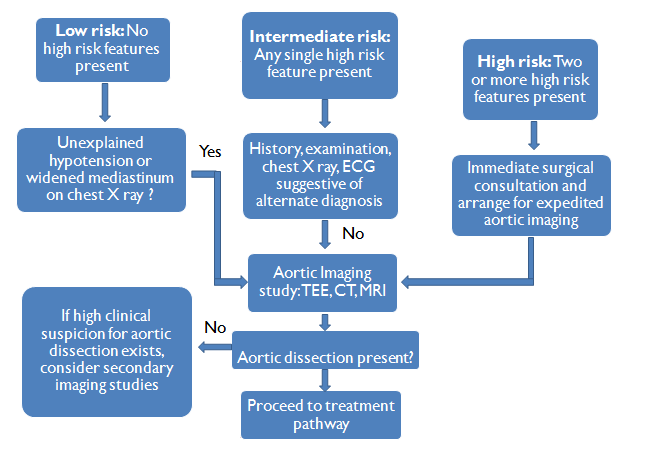Aortic dissection imaging in acute aortic dissection
|
Thoracic aortic aneurysm Microchapters |
|
Differentiating Thoracic Aortic Aneurysm from other Diseases |
|---|
|
Diagnosis |
|
Treatment |
|
Special Scenarios |
|
Case Studies |
|
Aortic dissection imaging in acute aortic dissection On the Web |
|
Aortic dissection imaging in acute aortic dissection in the news |
|
Blogs on Aortic dissection imaging in acute aortic dissection |
|
Directions to Hospitals Treating Aortic dissection imaging in acute aortic dissection |
|
Risk calculators and risk factors for Aortic dissection imaging in acute aortic dissection |
Editor-In-Chief: C. Michael Gibson, M.S., M.D. [1]; Associate Editor(s)-in-Chief: Aarti Narayan, M.B.B.S [2]
Overview
Approach to imaging in Acute aortic aneurysm

ACC/ AHA Guidelines - Recommendations for Screening Tests (DO NOT EDIT)
| Class I |
| 1. An electrocardiogram should be obtained on all patients who present with symptoms that may represent acute thoracic aortic dissection. |
| a.Given the relative infrequency of dissection-related coronary artery occlusion, the presence of ST-segment elevation suggestive of myocardial infarction should be treated as a primary cardiac event without delay for definitive aortic imaging unless the patient is at high risk for aortic dissection (Level of Evidence: B) |
| 2.The role of chest x-ray in the evaluation of possible thoracic aortic disease should be directed by the patient's pretest risk of disease as follows: |
| a. Intermediate risk: Chest x-ray should be performed on all intermediate-risk patients, as it may establish a clear alternate diagnosis that will obviate the need for definitive aortic imaging (Level of Evidence:C) |
| b. Low risk: Chest x-ray should be performed on all low-risk patients, as it may either establish an alternative diagnosis or demonstrate findings that are suggestive of thoracic aortic disease, indicating the need for urgent definitive aortic imaging. (Level of Evidence:C) |
| 3.Urgent and definitive imaging of the aorta using transesophageal echocardiogram, computed tomographic imaging, or magnetic resonance imaging is recommended to identify or exclude thoracic aortic dissection in patients at high risk for the disease by initial screening (Level of Evidence: B) |
| Class III (No Benefit) |
| 1. A negative chest x-ray should not delay definitive aortic imaging in patients determined to be high risk for aortic dissection by initial screening.(Level of Evidence: C) |